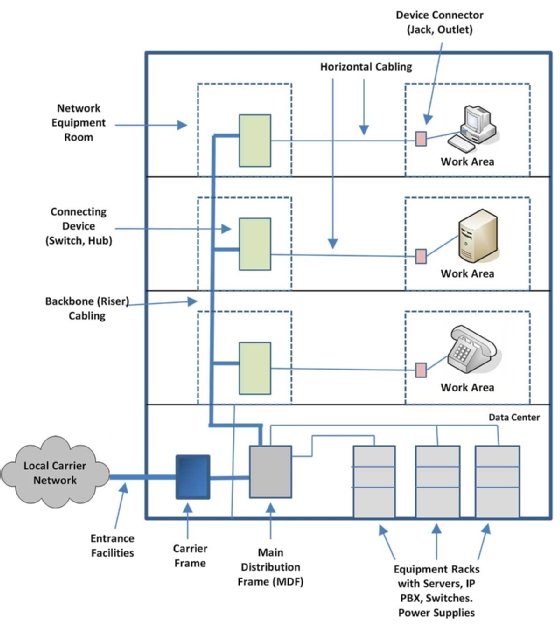
enterphoto - Fotolia
Navigate networking with cable management software
Cable management software has become an essential tool for managers keeping track of thousands of network components. Before you buy, make sure you know what you're getting.
Infrastructure managers have to track thousands of components needed to run their networks -- across a single building, multiple sites within a city or multiple buildings in an open campus.
Enter cable management software. These systems help admins pinpoint where every connection is, the type of cable and connectors used, and each connection made within the infrastructure.
Figure 1 illustrates the various kinds of cabling deployed in a typical building. Cable management software keeps track of the characteristics of each connection and the devices to which each cable segment connects, such as servers, IP private branch exchanges, switches, routers and hubs.

Cable management software tracks each network infrastructure element noted in Figure 1. Most software products also generate a visual map of the network with details of each element.
Cable management systems should be compatible with industry standards for cable and structured network distribution systems. The most widely used reference is the ANSI/TIA 568 series of standards that specifies how to implement both residential and commercial building cable distribution systems.
Pros and cons of cable management software
Cable management software is essential for today's complex enterprise networks.
Pros of cable management software
Benefits of cable management software include the following:
- Accurate cable infrastructure details. Verifies every connection, cable route and hardware component. This reduces the need for manual tracking using spreadsheets or other methods.
- Faster problem troubleshooting. Identifies potential issues quickly, speeding up repairs and reducing downtime.
- Efficient infrastructure management. Facilitates planning when changes to the networks are needed, reducing human errors.
- Flexibility and scalability. Adapts to infrastructure changes, such as adding more locations, moving an office or integrating cloud resources.
- Enhanced system integration. Links to specialized platforms such as data center infrastructure management (DCIM), configuration management database (CMDB), IT service management and network monitoring systems.
- Visualized infrastructure. Generates 2D and 3D images of the network.
Cons of cable management software
Drawbacks of cable management software include the following:
- Expensive. Costs can be significant, depending on the complexity of the network and the functions to be delivered.
- Learning challenges. Training is essential and learning the system may be time-consuming for both primary and alternate users.
- Maintenance requirements. Keeping the system database up to date can be challenging.
- Security and access control. Protecting the system from unauthorized access is a must; a breach could make network data visible to cyberattacks.
- Integration challenges. Connecting the system to work with a variety of platforms might require additional programming if the system can't perform the necessary interfaces.
Cable management software selection criteria
Organizations must ask vendor candidates important questions when evaluating prospective products. Examples of questions to ask include the following:
- Is the software locally deployed or is it cloud-based?
- Is it a commercial product or open source?
- How long does it take to build the database?
- What support does the vendor provide when building the database?
- How does the software visually display the network map?
- Can the software delineate between different types of cables and connectors?
- How much detail can the software capture for items like cable racks, patch panels, ports and cable routing paths?
- How easy is it to update the database?
- How are software updates, such as patches and downloads, delivered?
- How does the software present out-of-normal conditions?
- Does the software have a dashboard or similar feature to display the infrastructure in real time?
- How well does the software integrate with platforms such as DCIM and CMDB?
- How quickly can the software scale and adapt to changing requirements?
- What licensing issues must be addressed?
- Can a service level agreement be executed?
- What security features does the software have to protect it from cyberattacks?
- What are the pricing models -- per device and per user -- and what is the cost of maintenance?
- How is training provided?
- Is there a vendor help desk to handle problems?
Commercial and open source cable management products
Depending on the cable management requirements, commercial and open source products are available. The following two lists include examples of both types of products, in alphabetical order.
Commercial products
Examples of commercial products include the following:
- Device42. Offers strong discovery features and dependency mapping. Used for enterprise-level infrastructures.
- netTerrain DCIM. Handles a wide range of IT infrastructure requirements and delivers interactive visuals and detailed circuit maps.
- Patch Manager. Offers a wide array of tools and templates to track devices. Designed for large installations in buildings, data centers and campus infrastructures. Web- and SaaS-based options are available.
- Sunbird DCIM. Supports data center requirements while delivering active network monitoring of infrastructure attributes with a user-friendly dashboard.
Open source products
Examples of open source include the following:
- DCImanager. Details cable infrastructure. Designed for large enterprises.
- NetBox. Captures IP addresses, inventories devices and displays cable routes and rack maps. Designed for data centers and networking professionals.
- OpenDCIM. Tracks assets and details network infrastructure. Web-based tools are designed for enterprise DCIM requirements.
- RackTables. Details cable racks, including asset management. Tailored to SMBs.
- WireViz. Details cable infrastructures and displays detailed visual images. Designed for network engineers.
AI's influence on cable management
AI and machine learning are changing the face of cable management. Their benefits include the following:
- Improved cabling capabilities. Enhanced design and planning capabilities that accommodate all aspects of cabling, including its use in environmental systems, HVAC and power.
- Comprehensive performance analysis. Increased performance analysis features identify and predict potential faults and provide recommendations for active maintenance.
- Asset management. Enhanced asset tracking and management capabilities support large enterprises by extending to all parts of a network infrastructure.
- Threat detection. Security issue identification reduces the likelihood of unauthorized access to the system and ensures the network's overall integrity.
- Streamlined testing. Optimized testing and diagnostics highlight potential problems before they occur and monitor compliance with relevant industry standards, such as ANSI/TIA 568.
Paul Kirvan, FBCI, CISA, is an independent consultant and technical writer with more than 35 years of experience in business continuity, disaster recovery, resilience, cybersecurity, GRC, telecom and technical writing.









